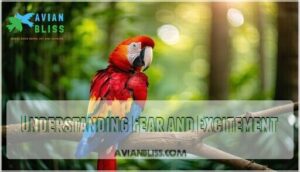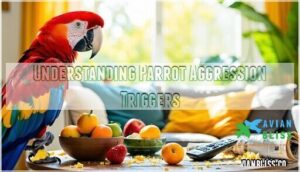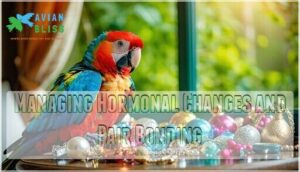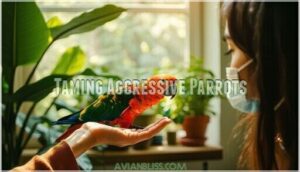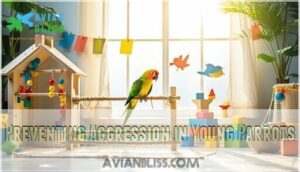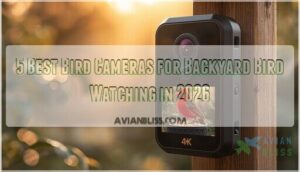This site is supported by our readers. We may earn a commission, at no cost to you, if you purchase through links.
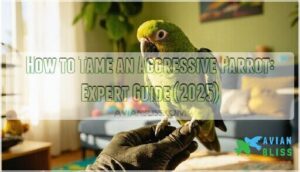
But here’s what most parrot owners don’t realize: aggression isn’t about hatred or dominance. It’s your bird’s way of saying something’s wrong—whether that’s fear, pain, hormones, or simply feeling trapped.
The good news? With the right approach, even the most defensive parrot can learn to trust again. Taming an aggressive parrot isn’t about forcing submission; it’s about understanding the language your bird speaks through feathers, eyes, and body posture, then responding with patience and strategy.
Table Of Contents
- Key Takeaways
- Identifying Aggressive Parrot Behavior
- Understanding Parrot Aggression Triggers
- Modifying The Environment to Reduce Aggression
- Desensitizing and Counterconditioning Techniques
- Resource Guarding and Redirecting Attention
- Managing Hormonal Changes and Pair Bonding
- Taming Aggressive Parrots
- Addressing Aggression Towards Specific Family Members
- Preventing Aggression in Young Parrots
- Seeking Professional Help and Support
- Frequently Asked Questions (FAQs)
- How to calm down an aggressive parrot?
- How to make an aggressive parrot friendly?
- What to do if a parrot is attacking you?
- Why is my parrot getting aggressive?
- Can diet impact my parrots aggressive behavior?
- How can I use toys to reduce aggression?
- Are certain parrot species more aggressive?
- What role does vocal communication play in aggression?
- How can exercise influence parrot aggression levels?
- How often should I handle my aggressive parrot?
- Conclusion
Key Takeaways
- Parrot aggression signals a problem like fear, pain, or hormonal changes rather than dominance, and you can decode these messages by watching body language—pinned eyes, fluffed feathers, and beak clicking warn you before a bite happens.
- Environmental tweaks matter more than you’d think: proper cage placement, noise reduction, enrichment activities, and eliminating perceived nest sites can dramatically reduce territorial behavior and stress-driven outbursts.
- Taming relies on positive reinforcement and gradual desensitization—reward calm behavior, respect your bird’s boundaries, use neutral territory like playgyms, and never force interaction when warning signs appear.
- Hormonal surges during breeding season turn sweet parrots aggressive, so limit physical contact to head-only, reduce light exposure to 8-10 hours daily, and remove dark cozy spaces that trigger nesting instincts.
Identifying Aggressive Parrot Behavior
Your parrot’s body language tells a story before a single bite happens. Learning to read these signals is like cracking a code that keeps both of you safe.
Let’s break down what your feathered friend is really saying.
Recognizing Body Language
Reading your parrot’s body language is like learning a foreign language—you’re looking for tiny signals that tell you exactly what’s brewing inside that feathered head. Feather signals matter most: fluffed-up plumage means "back off," while slicked-down feathers show calm. Eye movements called "pinning"—pupils rapidly expanding and shrinking—warn of excitement turning aggressive.
Body positioning matters too: a horizontal stance with a lowered head screams attack mode. Watch for beak postures like clicking or an open mouth, and listen for vocal cues like hissing or growling.
Feathers, Beak, and Eye Movements
Once you’ve spotted those fluffed feathers and tense body posture, it’s time to zoom in on the three areas that reveal your parrot’s true intentions: feathers, beak, and eyes. Pinning eyes—pupils rapidly dilating and constricting—signal brewing aggression or excitement. Beak clicking warns you to back off, while fluffed feathers show defensiveness. Wing displays make your bird look bigger when threatened.
Key body language signals to watch:
- Eye pinning movements: Pupils expanding and shrinking quickly mean emotional intensity that can flip to aggression.
- Feather fluffing patterns: Slicked-down feathers equal calm; puffed-up plumage screams "stay away."
- Beak clicking sounds: This sharp noise is your parrot’s way of saying "don’t push your luck right now.
Warning Signs of Imminent Attack
When those subtle signals escalate—lunging forward, open beak aimed at you, body crouched low with wings slightly raised—you’re looking at a parrot who’s seconds away from biting.
Pupil dilation intensifies, feather ruffling becomes more pronounced, and vocal warnings like hissing or growling accompany this defensive posturing. Your parrot’s body language screams "attack mode," with agitation peaking.
Back away slowly—don’t make sudden moves that might trigger the bite you’re trying to avoid.
Understanding Fear and Excitement
Here’s the tricky part: fear and excitement can look nearly identical in parrots, yet they require completely opposite responses from you. Both trigger pinning eyes and rapid head movements, but fear demands distance while excitement thrives on engagement.
Watch for context—environmental triggers like sudden noises usually signal stress, not enthusiasm. Your calm energy matters more than you’d think; parrots pick up emotional contagion fast, so staying relaxed helps prevent fear from escalating into aggression.
Common Misconceptions About Aggression
Let’s bust some myths that might be holding you back. Understanding parrot aggression triggers starts with ditching outdated ideas—dominance hierarchies don’t exist in wild flocks, and research shows aggression isn’t inherent.
Here’s what science actually tells us:
- Height doesn’t equal power: Your parrot perches high for safety, not to boss you around—forced removal increases defensive biting.
- Mislabeling signals backfires: That lunge might be fear, not rage; owners misidentify aggression 34% of the time.
- Punishment breeds problems: Frequent corrections increase fear and escape behaviors, worsening the very issues you’re trying to fix.
To prevent aggression, consider enriched environmental strategies.
Understanding Parrot Aggression Triggers
Your parrot isn’t lashing out randomly—there’s always a reason behind the aggression. Understanding what sets off your bird is the first step to solving the problem.
Let’s look at the most common triggers you need to watch for.
Environmental Triggers
Your parrot’s world is smaller than yours, and what seems like a minor change to you—a new lamp, a guest’s loud voice, or even rearranging furniture—can feel like a major earthquake to your bird. Environmental triggers like noise levels, routine changes, and cramped cage placement can spike stress fast. Think of it like this: if someone suddenly moved your bedroom furniture around while you slept, you’d wake up disoriented too.
| Environmental Trigger | Impact on Your Parrot |
|---|---|
| Loud or sudden noises | Creates fear triggers and defensiveness |
| Disrupted daily routines | Increases anxiety and territorial behavior |
| Poor cage placement | Reduces safe zones and calm environment |
Strategic toy rotation and creating a safe environment help minimize these stressors.
Social Interaction Triggers
When someone reaches for your parrot’s cage or a family member walks too close, does your bird suddenly turn from sweet to snappy? Social interaction triggers tap into your parrot’s body language cues and perceived threats. Human approach speed, new people entering the room, and routine disruptions can all spark aggressive behavior.
Three common social triggers that cause aggressive parrots to lash out:
- Unfamiliar visitors – Poor socialization makes your bird view strangers as threats
- Quick hand movements – Fast gestures signal danger in bird language
- Forced interaction – Ignoring "back off" signals escalates aggression
Understanding these patterns is the first step in behavior modification.
Resource Guarding and Competition
Ever watch two kids fight over the last cookie, or see a dog growl when you get near its favorite bone? Parrots do the same thing. Your bird might show food aggression at mealtime, toy competition with cage-mates, or perch dominance when another bird gets too close. Some parrots even guard their favorite human like a prized possession, displaying territoriality and jealousy that’d make a bodyguard jealous.
Understanding resource guarding helps you spot owner guarding and food bowl aggression before bites happen.
| Guarded Resource | Warning Signs | Management Strategy |
|---|---|---|
| Food bowl | Lunging during feeding, beak snapping | Feed separately, use multiple stations |
| Favorite toy | Charging when approached, territorial screaming | Rotate toys, provide duplicates |
| Chosen person | Biting others who approach owner | Encourage interactions with all family members |
Medical Issues and Pain
Sometimes a bird bites not because it’s mean, but because it hurts. Pain indicators like sudden aggression, avoidance during interaction, or unusual vocalizations often signal health problems hiding beneath the feathers.
Physical manifestations such as feather plucking, limping, or lethargy can point to disease triggers like respiratory infections or chronic arthritis. Medical conditions including Psittacine Beak and Feather Disease or internal infections make gentle birds defensive. Birds can also suffer from heavy metal poisoning, which may cause them to act aggressively due to the discomfort and neurological effects.
Environmental stressors—dirty cages, poor lighting, sleep deprivation—compound physical health issues. Diagnosis barriers exist when owners miss subtle pain signs or skip vet visits, leaving medical issues unresolved and aggression unchecked.
Hormonal Changes and Sensitivity
Hormonal changes can turn calm parrots into territorial tyrants, especially during breeding season. Factors such as daylight exposure above 12 hours, high-fat diets, and access to nest-like spaces fuel hormonal surges, leading to increased aggression. Watch for these behavioral signs:
- Wing drooping and regurgitation toward you or favorite toys
- Obsessive cavity exploration under furniture or inside dark spaces
- Territorial displays with excessive vocalization and lunging
To manage hormone-driven aggression, limit your parrot’s light exposure to 8–10 hours daily and restrict petting to the head and neck only. These techniques can significantly lessen aggressive behavior while your feathered friend navigates the emotional rollercoaster of nesting season.
Modifying The Environment to Reduce Aggression
Your parrot’s surroundings play a bigger role in behavior than you might think. Small tweaks to cage setup, daily routines, and sensory input can make a world of difference.
Here’s what you need to adjust to help your bird feel safe and calm.
Cage Placement and Size
Think of the cage as your parrot’s personal headquarters—if it’s cramped, noisy, or stuck in a high-traffic hallway, you’re basically asking for trouble. Cage placement can make or break your bird’s mood. Put it in a quiet corner where your parrot feels safe but not isolated.
Cage height matters too—parrots at eye level feel more confident and less defensive about their territoriality. Size-wise? Bigger is better for reducing cage aggression, with proper bar spacing and enrichment that gives your bird room to stretch without feeling trapped.
Reducing Stress and Overstimulation
A parrot’s nervous system isn’t built for chaos—too much noise, unexpected visitors, or constant activity can send stress hormones through the roof and turn even the sweetest bird into a feathered ball of anxiety. Creating a calm environment with consistent routines helps your parrot feel secure. Here’s how to dial down the stress:
- Soundproofing their safe space reduces overwhelming noise
- Limiting playtime prevents overstimulation and exhaustion
- Establishing quiet hours gives them predictable rest periods for fear reduction
Providing Enriching Activities
Boredom isn’t just an annoyance for parrots—it’s a fast track to aggression, feather-plucking, and screaming fits that’ll make your ears ring. Combat this by rotating puzzle toys weekly and hiding treats in foraging opportunities like crumpled paper or cardboard boxes.
Training games using positive reinforcement turn mental stimulation into bonding time, while social interaction prevents loneliness. Enrichment toys aren’t luxuries—they’re essential tools for behavior modification.
Creating a Safe Zone
Your parrot needs a designated retreat where they feel completely secure—a place where no one reaches in, no sudden movements happen, and stress simply melts away.
Create this safe zone with:
- Parrot-proof rooms free from ceiling fans, toxic plants, and open windows
- Secure perches positioned at comfortable heights away from high-traffic areas
- Calm environment using soft lighting and minimal disturbances during rest periods
This safe environment builds positive experiences and fosters desensitization techniques, transforming anxious birds into confident companions.
Noise Reduction Techniques
Loud environments can send even the calmest parrot into stress mode, so dialing down the decibels might be your secret weapon against aggression.
Try these noise reduction tricks to create that calm environment your bird craves:
| Technique | How It Works | Best For |
|---|---|---|
| Soundproofing cages | Cage covers muffle external noise | Night-time or busy households |
| Acoustic panels | Wall-mounted panels absorb sound waves | Rooms with echo problems |
| White noise | Masks sudden sounds that startle birds | Apartments or urban settings |
| Strategic placement | Position cages away from TVs, appliances | Reducing daily stressors |
| Quiet hours | Establish predictable calm periods | Preventing aggressive vocalizations |
When you control the soundscape, you’re actually preventing those stress-triggered outbursts before they start.
Desensitizing and Counterconditioning Techniques
When your parrot gets aggressive around certain triggers, you can actually retrain its emotional response through careful, step-by-step methods. These techniques work by gradually changing how your bird feels about things that set it off.
Let’s look at five practical approaches you can start using today.
Gradual Exposure to Triggers
If your parrot treats your hand like it’s the enemy, you’re not alone—most aggressive birds just need a little rewiring through systematic desensitization. Start with trigger identification, then build positive associations through incremental steps. Here’s your roadmap:
- Begin at a safe distance where your parrot stays calm.
- Pair each tiny step closer with high-value treats.
- Progress only when your bird relaxes—patience importance can’t be overstated.
Avoiding setbacks means watching body language carefully and never pushing too fast during these safe interaction techniques sessions.
Positive Reinforcement Training
With positive reinforcement training, you’ll reward calm actions instead of punishing outbursts—think treats when your parrot stays relaxed near your hand. Clicker training creates clear communication, while reward systems and shaping behavior through small wins build trust faster than you’d expect. Consistency matters because parrots learn through repetition, and these positive reinforcement techniques transform aggression into cooperation over time.
| Training Method | How It Works | Your Parrot’s Win |
|---|---|---|
| Clicker Training | Sound marks good behavior | Clear expectations |
| Reward Systems | Treats follow calm actions | Motivation boost |
| Shaping Behavior | Small steps toward goals | Confidence grows |
| Consistency Matters | Same rules every session | Security and trust |
| Building Trust | Patience over pressure | Lasting bond forms |
Counterconditioning to Reduce Fear
When your parrot’s fear turns into a bite, counterconditioning flips the script by replacing that anxious reaction with a calm, happy response. You’ll pair trigger association with positive outcomes—like offering a favorite treat when your aggressive parrot spots the feared object from a distance.
Through gradual introduction and a consistent reward system, you’re teaching fear replacement that sticks. This counterconditioning works alongside desensitization and positive reinforcement to rebuild trust.
Desensitization to Foot and Hand Interactions
Hands trigger more bites than anything else because they’re the tool you’ll use most—and the one your parrot sees as a threat until you prove otherwise. Start desensitization training by placing your hand near the cage without reaching in. Through gradual approach and hand introduction, you’ll build trust.
Try foot targeting exercises where your parrot touches a target stick for treats—positive association makes safe interaction techniques second nature. Taming aggressive parrots means proving you’re predictable, not pushy.
Reducing Over-Excitement
Think of your parrot like a toddler hopped up on birthday cake—too much excitement flips the fun switch straight into chaos. When calming aggressive parrots, behavior modification through stress reduction works wonders. Here’s your game plan for routine predictability:
- Cap playtime at 15-20 minutes—Playtime Limits prevent overstimulation
- Create a quiet safe space using Soundproofing Environment techniques
- Schedule consistent rest periods in designated Safe Zones
- Use Calming Techniques like soft talking and dimmed lighting
These calming techniques transform your bird’s emotional thermostat from "volcano mode" to "chill mode.
Resource Guarding and Redirecting Attention
Resource guarding happens when your parrot gets possessive over food, toys, or favorite spots—and it can turn into aggressive behavior fast. The good news is you can teach your bird to share without a fight by redirecting their focus and building better habits.
Let’s look at practical ways to manage guarding behavior and keep everyone safe.
Food and Toy Guarding
Some parrots cling to their favorite toys or food bowls like they’re defending Fort Knox, and understanding this instinct is the first step to helping them relax. Resource guarding and toy hoarding are natural behaviors rooted in survival, but they don’t have to rule your home.
Use positive reinforcement to reward calm behavior near prized items. Try rotating toys regularly to prevent territory squabbles, and place food bowls in neutral spots to reduce food dominance and resource defense triggers.
Redirecting Attention to Toys and Activities
Instead of battling over every bowl and bell, you can teach your parrot that toys and activities are way more fun than guarding them. Channel that fiery energy into mental stimulation through enriching activities:
- Toy Rotation keeps things fresh and prevents obsessive guarding
- Foraging Opportunities and Puzzle Toys satisfy natural hunting instincts
- Training Games redirect Aggressive Parrot Behavior into cooperation
- Activity Variety fights boredom before Resource Guarding starts
Use Positive Reinforcement Training to reward engagement over defensiveness.
Teaching Drop It and Leave It Commands
Once your parrot knows playing with toys is fun, it’s time to teach them they can also let go of those toys—without drama. Start with "Drop It" using positive reinforcement—offer a high-value treat when your parrot releases an item.
Practice "Leave It" by rewarding them for ignoring tempting objects. These commands benefit safer interaction and reduced guarding.
This step-by-step guide builds generalization skills through consistent behavior modification and troubleshooting patience.
Encouraging Social Interaction
Now that your parrot understands boundaries around toys and food, it’s time to help them enjoy being around people—not just their favorite perch or snack bowl. Parrots naturally understand flock dynamics, so use positive reinforcement during playdates to build trust.
Introduce new family members gradually, watching for social cues. Enrichment activities encourage socialization without pressure. Your parrot’s behavior transforms when they feel safe exploring relationships on their terms.
Managing Hormonal Changes and Pair Bonding
When breeding season rolls around, your parrot might turn into a feathered Jekyll and Hyde. Hormonal surges can make even the sweetest bird suddenly territorial, possessive, or downright grumpy.
Let’s look at practical ways to manage these seasonal mood swings and keep everyone safe.
Recognizing Hormonal Surges
Your parrot might seem sweet most of the year, but once breeding season hits, it’s like someone flipped a switch—suddenly you’re dealing with aggressive displays, territorial outbursts, and a bird who thinks everything (including you) is either a mate or a rival.
Watch for signs like regurgitating food, nest-building attempts (shredding paper, hiding in dark spaces), increased vocalizations, and heightened territorial behavior. These hormonal surges usually peak during spring but can vary by species and your home’s lighting conditions.
Reducing Unhealthy Pair Bonding
If your parrot has decided you’re their one-and-only soulmate and throws a feathery fit whenever you interact with anyone else, you’re dealing with unhealthy pair bonding—and it’s time to gently reset those boundaries.
This mate aggression stems from hormonal changes that trigger jealousy and territoriality, making your bird view others as rivals.
Here’s how to redirect affection and manage pair bonding:
- Limit contact during hormonal surges—no petting beyond the head, which can trigger breeding behaviors.
- Encourage independent play with foraging activities that keep your parrot mentally engaged without relying on you.
- Remove perceived nest sites by managing dark, cozy spaces your bird might claim as nesting territory.
Encouraging Independent Play
Teaching your parrot to play solo isn’t just about preventing clinginess—it’s about giving them the confidence to explore, problem-solve, and entertain themselves without needing you as their constant companion.
Start with Toy Rotation—swap out puzzle toys every few days to maintain novelty and mental stimulation. Create Foraging Opportunities by hiding treats in paper bags or cardboard tubes, encouraging Safe Exploration through environmental enrichment. Use positive reinforcement to reward Solo Activities, building independence through structured, enriching activities.
| Strategy | Implementation |
|---|---|
| Toy Rotation | Swap 2-3 puzzle toys weekly to maintain interest |
| Foraging Setup | Hide treats in shreddable materials daily |
| Playtime Schedule | Designate 20-minute independent sessions twice daily |
Limiting Physical Contact
When breeding season hits, too much petting and snuggling can accidentally trigger hormonal aggression—so dialing back physical contact isn’t about showing less love, it’s about keeping your parrot calm and comfortable.
Focus on Respectful Distance by switching to verbal praise instead of stroking. Master Reading Signals—watch for eye pinning or raised feathers before touching. Practice safe management techniques when necessary, using Gradual Introduction to rebuild confidence through brief, positive interactions that respect your bird’s boundaries.
- Avoid head and back scratches during breeding season (stick to beak or foot management)
- Use protective gear like towels for safe management during hormonal peaks
- Reward calm behavior from a distance to maintain trust without overstimulation
Managing Perceived Nest Sites
Dark, cozy corners might seem harmless, but to a hormonal parrot, they’re an open invitation to nest—and that’s when the real territorial trouble starts. You’ll need to block access to cupboards, boxes, and shadowy spots that trigger nesting behaviors. Think of it as bird-proofing for breeding season—removing temptation before cage aggression kicks in.
| Perceived Nest Site | Why It Triggers Territoriality | Safe Alternatives |
|---|---|---|
| Cardboard boxes | Enclosed spaces mimic natural cavities | Open perches and rope swings |
| Behind furniture | Dark corners activate nesting season instincts | Well-lit play areas with visibility |
| Under blankets/towels | Soft, dark materials encourage weaving | Foraging toys and puzzle feeders |
| Inside cabinets | Privacy signals territory defense | Neutral ground playgyms outside cage |
Use redirection tactics by offering engaging activities when your parrot investigates problematic areas. Cage security means keeping the environment open and well-lit, which naturally discourages territorial behavior without triggering stress.
Taming Aggressive Parrots
Taming an aggressive parrot isn’t about forcing your bird to behave—it’s about earning trust and teaching your feathered friend that you’re not a threat.
The process takes patience and consistency, but you’ll see real progress when you follow proven techniques.
Here are the key strategies that work for even the most challenging parrots.
Establishing Trust and Respect
Trust isn’t built overnight—think of it like teaching a wild bird to eat from your hand, except this time the bird already lives in your house and has opinions about your cooking. Start by sitting near the cage without demanding anything. Speak softly and keep your movements slow.
Feed at the same times daily—predictable routines reduce fear. Offer treats through the bars to create positive experiences. Let your parrot choose when to step up. That’s voluntary contact, and it’s worth the wait.
Predictable routines reduce fear—offer treats through the bars, let your parrot choose when to step up, and trust builds through voluntary contact worth waiting for
Keep training sessions short, around 15 minutes, so nobody gets stressed.
Encouraging Self-Release
One of the best ways to continue that trust-building work is to let your parrot decide when it wants to leave the cage. Open the door and step back—don’t reach in or hover. This voluntary exit teaches your bird that gentle interaction and safe return are guaranteed, not forced. Use positive reinforcement when it explores independently, offering treats and calm praise. Over time, reducing dependence on your prompting builds confidence.
Taming aggressive parrots through independent exploration means:
- Leaving the cage door open without reaching inside
- Rewarding your parrot when it steps out on its own
- Keeping your body language relaxed and non-threatening
- Allowing safe interaction techniques by letting the bird approach you first
- Building trust through patience, not pressure
Gradual Approach and Interaction
After your parrot gains confidence stepping out alone, the next achievement is learning that human interaction doesn’t have to mean danger—but this takes baby steps, not big leaps.
Sit nearby, speak softly, and offer treats when you see calm body language. By creating a soothing atmosphere and letting contact stay voluntary, you build familiarity, positive associations, and a stronger bond with your bird.
Neutral Ground and Playgyms
Moving your bird to a playgym—away from its cage—can feel like hitting a reset button on bad habits. In this neutral location, your parrot isn’t defending territory, making stepup training and positive reinforcement more effective.
Design the playgym as a safe space with perches, toys, and treats. Introduce it gradually with supervised access, building positive associations that make this safe zone a place your bird actually wants to explore.
Rewarding Calm Behavior
Catching your parrot doing something right—staying perched calmly, keeping its feathers smooth, or simply not lunging—deserves the same kind of celebration you’d give a toddler using their first fork.
Offer treats immediately when you spot calm behavior, creating a positive association between stillness and rewards. Clicker methods work beautifully here: one click, one treat, consistent rewards every time.
You’re shaping behavior gradually, teaching your bird that being chill pays off better than throwing a tantrum.
Addressing Aggression Towards Specific Family Members
Your parrot might love you but act like your spouse is public enemy number one. When parrots target specific family members with hisses, lunges, or bites, there’s always a reason behind it.
Let’s look at practical steps you can take to help your bird accept everyone in the household.
Identifying Triggering Behaviors
Sometimes the difference between a friendly squawk and an all-out attack comes down to spotting the subtle things we do that set our parrots off. Understanding parrot behavior means paying attention to environmental cues and social signals that trigger aggression. Watch for these warning signs:
- Body language shifts when specific family members approach—pinning eyes or raised feathers signal discomfort
- Vocalizations that escalate during certain interactions, like cage cleaning or holding attempts
- Resource competition behaviors when particular people come near food bowls or favorite toys
- Hormonal changes causing territorial responses toward select household members during breeding season
Implementing CAT (Constructional Aggression Treatment)
Constructional Aggression Treatment (CAT) works through negative reinforcement—when your aggressive parrot stays calm near a specific family member, that person steps back, rewarding the bird’s tolerance. This stepwise approach requires precise timing and careful observation of body language.
Here’s how CAT creates measurable outcomes for companion parrots:
| CAT Stage | What Happens |
|---|---|
| Starting Distance | Family member stands where bird stays relaxed—no aggression triggered |
| Brief Sessions | 3–5 minutes daily; bird shows calm, person retreats as reward |
| Gradual Approach | Move closer only when bird consistently tolerates previous distance |
| Measurable Success | Aggression drops noticeably within 1–2 weeks with proper technique |
Critical factors include the need for skill in reading subtle feather shifts and eye pins. One mistimed move can worsen aggression instead of fixing it. Combine CAT with enrichment and behavior modification for lasting results in desensitizing and counterconditioning techniques.
Reducing Negative Associations
Parrots don’t forget the times you’ve accidentally scared them or mishandled them—those memories stick like glue, and they’ll defend themselves the next time they see that same trigger coming. You’ll need to identify exactly what sparked the past trauma—maybe it was a towel, a certain hand movement, or even a specific room.
Once you’ve nailed down the trigger, use desensitization by introducing it from a safe distance while pairing it with positive reinforcement like treats. This counterconditioning gradually replaces fear with calm, safe interactions, rebuilding trust one session at a time.
Encouraging Positive Interactions
Building a bond with your parrot isn’t just about avoiding the bad stuff—it’s about stacking up so many good moments that your bird actually looks forward to spending time with you. Here’s how to create those trust-building experiences:
- Hand-feed favorite treats during calm moments to strengthen positive associations with your presence
- Use gentle interaction techniques that respect boundaries—let your parrot step up voluntarily
- Incorporate vocal communication with soft, cheerful tones during interactions
- Reward calm behavior immediately with praise or treats to reinforce positive interactions
Positive reinforcement methods transform wary birds into willing companions.
Managing Conflict and Aggression
If your parrot’s aggression has you feeling like a referee in a feathered boxing match, it’s time to shift from reacting to managing—because understanding what drives the conflict is half the battle.
Start with de-escalation tactics: read body language before things escalate, and create distance when tensions rise. Practice safe interaction by respecting boundaries—never force interaction when your aggressive parrot shows warning signs.
Set clear boundary setting rules consistently, and use bite inhibition training through positive reinforcement to teach gentler responses, reducing aggression one calm moment at a time.
Preventing Aggression in Young Parrots
Raising a young parrot the right way is like teaching a kid good habits—it’s way easier to prevent problems than to fix them later. The first few months shape how your bird manages stress, fear, and new people for the rest of its life.
Let’s look at three key strategies that’ll set your feathered friend up for a calm, confident future.
Socialization and Handling Techniques
You wouldn’t bring home a puppy without teaching it manners, so why expect a young parrot to magically know how to behave around humans? Early socialization is your secret weapon against future aggression. Start gentle interaction from day one—let your parrot step onto your finger, explore new perches, and meet different people in calm, positive interactions. Building trust through safe interaction methods means no sudden grabs or loud reactions when they nip. Here’s your game plan:
- Begin socialization during the weaning period for best results
- Use treats to reward calm behavior during interaction sessions
- Introduce new people gradually, keeping interactions brief and pleasant
- Practice gentle interaction daily, respecting your parrot’s body language
- Avoid triggers like forceful restraint that create fear-based responses
Encouraging Independence
Just like toddlers who cling to their parents, young parrots can develop an unhealthy attachment that backfires into biting and screaming—so teaching independence early saves you both from future headaches.
Set up enriching activities like foraging opportunities where your parrot hunts for hidden treats, building confidence through solitary exploration. Rotate toys regularly for mental stimulation, and balance socialization needs with independent play sessions.
This teaches self-soothing skills that prevent clingy, aggressive behaviors down the road.
Managing Fear and Anxiety
Fear can turn your confident little explorer into a biting bundle of nerves faster than you can say "step up." Building trust with interacting with fearful birds requires patience and smart calming techniques:
- Secure Environment – Keep the cage in a quiet corner away from chaos
- Routine Predictability – Feed and play at consistent times daily
- Positive Associations – Pair your presence with favorite treats
- Gradual Acclimation – Introduce new things slowly, never rushing
This anxiety management creates trust building that lasts.
Seeking Professional Help and Support
Sometimes, despite your best efforts, aggression persists or worsens—and that’s when calling in an expert makes all the difference. Professional avian behaviorists bring specialized knowledge that can identify problems you might miss on your own.
Here’s how to find the right help and what to expect when you do.
Recognizing The Need for Professional Help
When do you step back, take a breath, and admit your parrot’s aggression needs outside expertise? If you’ve tried behavior modification for weeks without progress, or if bites are getting worse, it’s time for professional support.
An avian veterinarian can rule out medical issues, while a parrot behavior consultant or avian behaviorist offers expert advice on flock aggression and ongoing support, including medication options when necessary.
Finding a Qualified Avian Behaviorist
Now that you’ve decided professional support is the right move, tracking down a qualified avian behaviorist doesn’t have to be a guessing game. Start with certification standards like CAAB or CPBT-KA—these credentials mean real training in learning science and parrot-specific behavior. Look for experience requirements too: at least two to three years working hands-on with birds.
The IAABC and AVSAB websites let you search by location, and many avian vets can refer you to trusted parrot behavior consultants. Ask about their key competencies—can they assess your bird’s triggers and design a positive reinforcement plan? Continuing education matters, so choose someone who stays current with avian research and methods.
Creating a Behavior Modification Plan
A solid behavior modification plan acts like a GPS for your parrot’s recovery—it maps out where you’re, where you want to go, and the step-by-step route to get there without meltdowns along the way.
Start with goal setting—what calm behaviors do you want? Track data collection daily: note triggers, bites, and wins.
Choose intervention strategies rooted in positive reinforcement and training techniques that address underlying causes.
Review progress evaluation weekly, then make plan adjustments as your bird improves.
Managing Aggression in Flocks
Multi-bird households can feel like refereeing a feathered soap opera, where territorial disputes and jealousy flare up faster than you can say "step up." Understanding flock dynamics means recognizing who’s boss and who’s just bluffing.
Space management and resource allocation—like separate feeding stations—reduce competition. When introducing birds, go slow with supervised socialization sessions. Watch for territorial behavior like wing displays or vocal communication that signals trouble.
Use conflict resolution strategies rooted in building trust with birds, not punishment.
Ongoing Support and Guidance
Taming an aggressive parrot isn’t a one-and-done mission—it’s more like training for a marathon where the finish line keeps moving. That’s why long-term planning matters.
Support groups and a parrot behavior consultant offer expert advice when you’re stuck. An avian behaviorist creates behavior modification plans specific to your bird’s quirks.
Emergency care matters if things escalate. Seeking professional help leads to positive outcomes and a harmonious relationship built on trust.
Frequently Asked Questions (FAQs)
How to calm down an aggressive parrot?
Calming an aggressive parrot starts with recognizing warning signs like pinned eyes or raised feathers. Step back, speak softly, and avoid sudden movements.
Once your parrot settles, offer a favorite treat through the cage bars to rebuild trust and create positive associations.
How to make an aggressive parrot friendly?
Transforming an aggressive parrot into a friendly companion starts with respecting boundaries—never force interaction. Gradually introduce high-value treats through cage bars to create positive associations.
Use positive reinforcement training to reward calm behavior, and establish consistent routines that reduce triggers while building trust through patient, gradual socialization.
What to do if a parrot is attacking you?
During an attack, has your heart ever raced as wings flapped toward you? Stay calm and don’t make quick movements—that only escalates things. Use a towel or pillow as protective gear for safe restraint techniques.
Slowly back away, giving space. Seek help if injury occurs during parrot aggression encounters.
Why is my parrot getting aggressive?
Aggression often stems from hormonal fluctuations, environmental stressors, or medical conditions causing discomfort. Your parrot’s fear response to unfamiliar situations or social deprivation can trigger defensive behaviors.
Watch for underlying causes like pain, boredom, or territorial instincts driving these outbursts.
Can diet impact my parrots aggressive behavior?
Absolutely—diet plays a bigger role than most people realize. High-fat seeds and sugary treats can spike your parrot’s energy and irritability, while nutritional deficiencies might leave them cranky and uncomfortable.
Switch to balanced pellets, fresh veggies, and proper hydration to help smooth out those mood swings naturally.
How can I use toys to reduce aggression?
Toys become powerful tools when they channel your parrot’s energy into something constructive instead of combative. Try foraging toys that make your bird work for treats—they’ll stay occupied and mentally stimulated.
Destructible toys satisfy their natural urge to shred and destroy. Puzzle feeders turn mealtime into brain games.
Rotate toys weekly so novelty keeps boredom at bay.
Are certain parrot species more aggressive?
Certain species definitely show stronger aggressive tendencies. Cockatoos, Amazons, and some macaw species tend to display more intense behaviors due to their intelligence and complex social needs.
However, individual temperament, early experiences, and how you meet their species-specific needs matter just as much as genetics in shaping parrot behavior and preventing parrot aggression.
What role does vocal communication play in aggression?
Every hiss, screech, or growl tells a story. Vocal communication reveals your parrot’s emotional state before aggression escalates—listen for sudden pitch changes, louder volume, or repetitive threat squawks that warn you to back off and give space.
How can exercise influence parrot aggression levels?
Regular exercise acts like a pressure valve for your parrot, releasing pent-up energy and stress that might otherwise fuel behavioral issues.
Flight opportunities and enrichment activities provide mental stimulation alongside physical movement, preventing boredom and dramatically reducing aggressive outbursts through natural, healthy outlets.
How often should I handle my aggressive parrot?
Start with brief sessions—around 10 to 15 minutes daily—and let your parrot set the pace. Never force interaction if you see warning signs like pinning eyes or raised wings.
Building confidence takes time, so prioritize reading signals over pushing contact.
Conclusion
Taming an aggressive parrot isn’t about clipping their wings—it’s about earning their trust, one calm interaction at a time. You’ve learned how to tame an aggressive parrot by reading body language, removing triggers, and using positive reinforcement to reshape fear into confidence.
Aggression doesn’t vanish overnight, but with patience, your bird can transform from defensive to delightful. The turning point—when your parrot steps onto your hand willingly—makes every setback worth it. Stay consistent, stay compassionate, and watch your feathered friend finally relax.
- https://www.imdb.com/title/tt0107290/
- https://www.theposhperch.com/blogs/bird-talk/how-to-handle-a-parrot-exhibiting-aggressive-behavior
- https://avian-behavior.org/changing-your-parrots-diet/
- https://www.beakschool.com/free-5-day-membership-trial
- https://www.behaviorworks.org/files/articles/Alternatives%20to%20Parrot%20Breaking%202002.pdf




